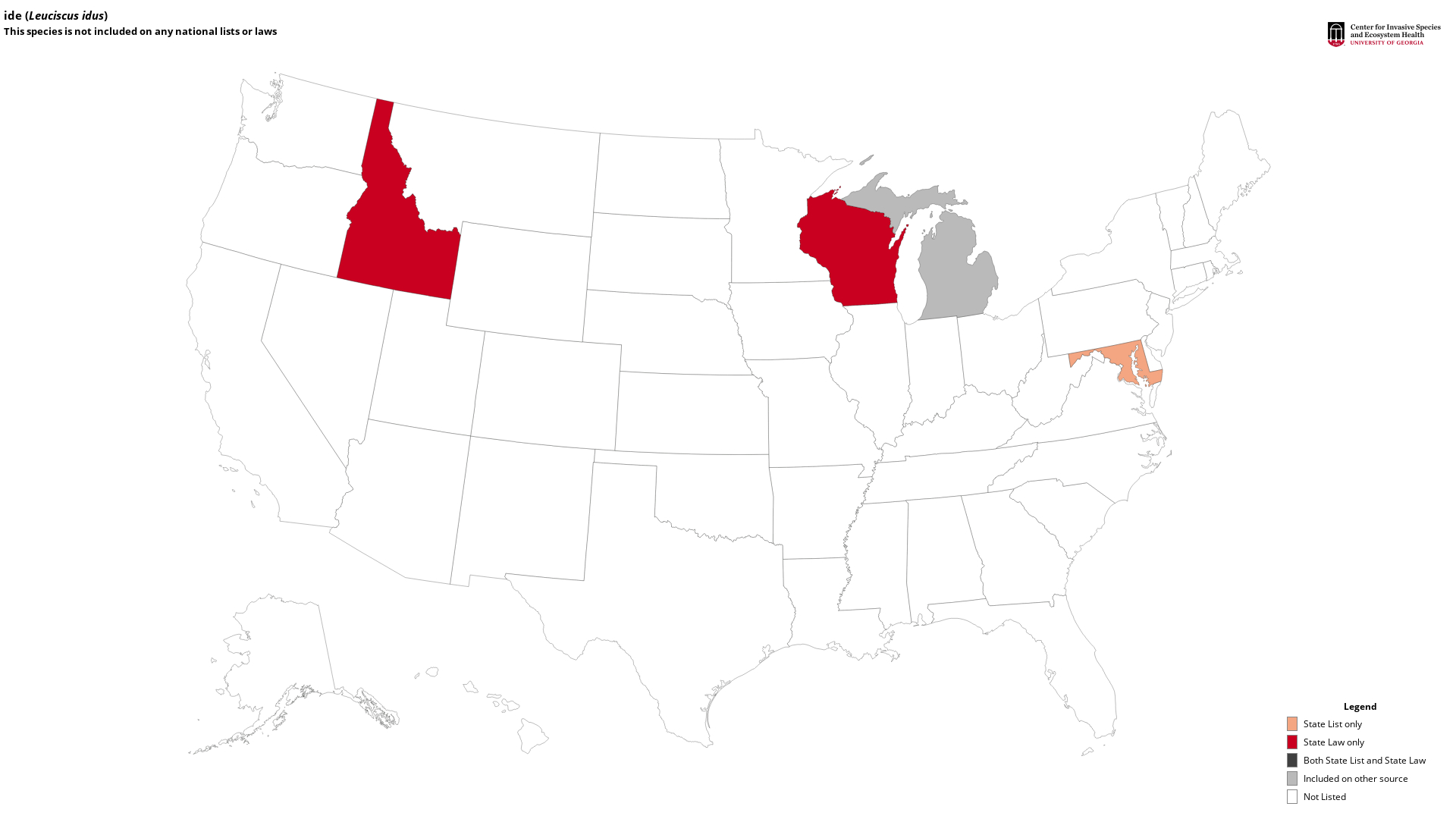ide
(Leuciscus idus)
This species is Introduced in the United States
Overview:
The ide, or orfe, is a freshwater, ray-finned fish of the carp family, native to most of mainland Europe and western Asia.1 It is a large-bodied fish valued for sportfishing and as an ornamental pond fish. There are two color morphs - 'silver orfe' and 'golden orfe' - but the ornamental golden orfe can revert to wild coloration with time.1
The ide or orfe was imported to the U.S. in the late 1800s and cultured by the government. It has subsequently escaped from both public and commercial culture operations, particularly during floods.1
L. idus can also occupy the brackish waters of estuaries. It has a higher tolerance for salinity than other carp species.1 There is a lack of information of its impact on habitats or biodiversity. However, risk factors include: broad native range, adaptable to different environments, a habitat generalist, and long-lived. It is a member of the carp family and several introduced carp species have proven to be very invasive.1 Larger individuals feed mainly on fishes.3
L. idus is capable of hybridizing with other introduced cyprinids such as common carp and rudd. It has no known hybrids with native North American fishes.1
L. idus is similar looking to rudd (Scardinius erythrophthalmus), another non-native, invasive fish. Both have orange-red coloured fins but L. idus has much smaller scales.1 It is also superficially similar to many native cyprinids but can be distinguished by no barbels, lateral line scales 55-63, and usually 8 branched dorsal rays.1
As of January 1, 2016, the possession, sale, or transport of this species in Alberta is unlawful under the Fisheries Act.
Habitat:
Clear pools of medium to large rivers, lakes, and ponds.1 It retreats into deep holes during winter.2 Low oxygen concentrations(<2 mg/l) result in larval and juvenile mortalities.1 Preferred water temperature range of 4-20º C. Tolerates brackish water.1
Identification:
L. idus have a typical minnow-shaped body, is moderately thick, and older adults have a raised humped back.1 The lower sides are light or silvery in color and adults are dark on the back and sides above the lateral line. The wild form is greyish-olive color on the back paling to silvery-white on the belly and all fins except the dorsal fin have a reddish tinge. The ornamental variety has a bright orange back, silvery-orange sides and belly, and bright orange tail and dorsal fin.1
The snout is blunt and the mouth small and oblique. The lateral line has 55-63 scales. Gill rakers are short and widely spaced with 10-14 on the first arch.1 The pharyngeal teeth are conic, not serrated, and arranged in two rows. The dorsal in has 3 spines, 8-11 soft rays, the anal fin 3 spines and 8-11 soft rays, and the caudal fin has 19 rays.1
Average weight is 680 g1 and the maximum reported weight is 4 kg.3
Ecology:
Ide or orfe move to shallower waters for spawning when water temperatures are 7-14 oC.1 Adults spawn in schools over weed beds or gravel. Eggs are pale yellow, about 2mm in diameter, and attach to stones or vegetation.1 Hatching occurs in 1-2 weeks, depending on water temperature. Newly hatched fish are 8-10 mm long.1
Females spawn once per year3 and produce from 15,000 to 125,000 eggs.1
L. idus are sexually mature by ages 3-5 years. Total body length varies from 22-43 cm and males may be smaller than the females.1 The maximum reported age is 18 years.3
They feed on crustaceans, insect larvae, worms, snails, and some vegetation. Adult fish are predatory.1
Economic Impacts:
The ide or orfe's diet competes directly with native fish for food.1 The consumption of other fish species negatively impacts the populations of native fishes.1 The decline of native sportfish populations could have impacts on recreation and tourism.
Environmental Impacts:
The ide or orfe's adaptability to many different environments competes directly with native fish for habitat.1 Competition for food resources and consumption of other fish species negatively impacts the populations of native fishes.1
Sociological Impacts:
The transformation of native aquatic communities results in the intrinsic loss of natural capital and enjoyment of natural areas.
Prevention:
Learn how to identify ide or orfe and how to prevent spread. Do not purchase or keep ornamental orfe. Never, ever empty your aquarium into natural water bodies.
Control:
There are currently no established control measures for ide or orfe, however, practices used on other carp species may be effective.1 If caught, ide or orfe should be killed and not released.
References:
1Datasheet report for Leuciscus idus (ide). Invasive Species Compendium. www.cabi.org/isc/datasheetreport?dsid=77315 Accessed: December 9, 2016.
2Global Invasive Species Database (GISD) 2015. Species profile Leuciscus idus. Available from: www.iucngisd.org/gisd/species.php?sc=613 Accessed: December 9, 2016.
3Leuciscus idus (Linnaeus, 1758) Ide. www.fishbase.ca/summary/Leuciscus-idus.html Accessed: December 18, 2016.
Selected Images
Maps
State Lists - This map identifies those states that have this species on their invasive species list or law.
Invasive Listing Sources
Taxonomic Rank
| Kingdom: Animalia |
| Phylum: Chordata |
| Subphylum: Vertebrata |
| Class: Actinopterygii |
| Subclass: Neopterygii |
| Order: Cypriniformes |
| Family: Cyprinidae |
| Genus: Leuciscus |
| Subject: Leuciscus idus Linnaeus, 1758 |
References
Common Name Reference: Integrated Taxonomic Information System on-line database.
Scientific Name Reference: Integrated Taxonomic Information System on-line database.

